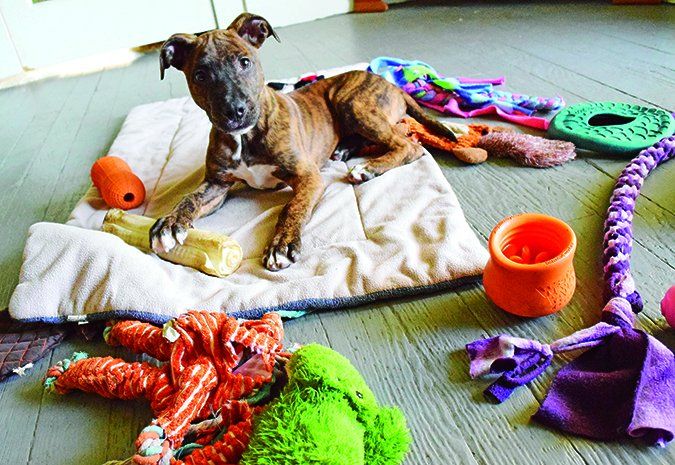Puppies! Who doesn’t love ’em? They’re cute, cuddly, and silly. They look like little angels when they sleep, which is often. When they’re awake, they spend all their time exploring and learning about the world around them. We marvel at their curiosity and playfulness – until we experience The Teeth.
Puppies explore with their mouths, which nature has equipped with rows of teeny-tiny hole-punchers. It’s no fun being at the receiving end of a bitey pup. It hurts! It’s no wonder that the leading complaint from puppy owners is “How do I stop him from biting?”
The short answer is: You don’t! As Pat Miller explains in, “Teaching Your Puppy Bite Inhibition,” (May 2017), smart owners do everything they can to help their puppies develop “bite inhibition” over time.
However, this doesn’t mean you allow your puppy to puncture and hurt you! There are a number of things you can do to manage a nippy puppy until your puppy outgrows this important developmental stage.
The following is a list of things you can do to keep your skin, clothes, and other belongings intact while your puppy works through the biting phase:
1. Get lots of chew toys. Seriously, lots of them. Don’t skimp on the number or variety of chew toys your puppy has access to. Owners are often advised to keep only one or two toys out at a time (and to rotate them) so that their dogs don’t become bored, but this does not apply to puppies!
Instead, make sure that there is an ample supply of appropriate things your puppy can pick up with his mouth as he explores his home. (Remember that to a puppy, literally everything in his path is a chew toy, so it’s up to you to ensure your things – shoes, plants, remote controls, etc. – are safely stored.)
Further, when your puppy does pick up a toy, take advantage of the moment to reinforce this good behavior by showering him with attention. Think about it – if you ignore him when he picks up the correct item, but shout and jump around when he grabs your toes (or shoes), he’ll quickly learn that biting toes (or shoes!) is a sure way to get your attention. Showing him that picking up a toy, instead, is indeed the best way to get your attention will pay off in the long run.
Get the complete story on a dog’s need to chew things in, “Take Control of Puppy Chewing,” (March 2016).

2. Introduce your pup to “latch ropes.” This doesn’t have to be anything special; the term describes any long item that can be dragged behind you as you move through your home.
Moving objects are an open invitation for puppies to latch on with their teeth. Feet, pant legs, bath robe hems – they’re all fair game! I suggest to clients that they make several of their own “latch ropes” and keep them handy, all over the house. That way, when they walk from the living room to the kitchen, they can grab the closest latch rope and drag it behind them as they move. Puppy is more likely to latch onto that than to moving human feet. This is especially useful for kids who may feel terrorized by their new friend each time they walk or run through the house.
You don’t need to buy a bunch of these toys; they are easy and inexpensive to make. You can cut an old beach towel or large bath towel in half (lengthways) to make two separate toys. Tie a knot in the center, then two smaller knots on each end. Or, ask your friends and family members to donate their old pairs of jeans. Cut the pant legs off, and then cut each pant leg into several long strips of fabric that you can then braid to make a denim rope. All of these homemade toys can easily be tossed into the washer when needed.
3. Redirect your pup to a “legal” object to bite. Simply petting your puppy can sometimes prove difficult. He may view your hands on him as an invitation to play – and that means using his teeth! Scrambling to save your fingers from a chomping puppy mouth can look like the legendary Buster Keaton “sticky fingers” comedy routine – as soon as you free one hand, the puppy has latched on to the other! Try holding a chew toy for your puppy to gnaw on while your other hand gently strokes him. When done correctly, this is an excellent bonding experience.
4. Toss his treats on the floor. Delivering a treat to a bitey puppy during training requires some skill. Avoid pinching the treat between your thumb and index finger, or your puppy’s teeth may clamp down on your fingers. Instead, offer the treat in the palm of your open hand, or, better yet, toss it to the floor.
There’s an extra advantage to tossing treats directly on the floor: Your puppy will learn to anticipate that good stuff is delivered on the ground, and not necessarily from the hand. This will help curb his interest in human hands, and will result in less jumping up to bite them. It is especially helpful in keeping children’s tiny hands safe.
Avoid Saying “No!”
Shouting once or twice might work by startling your puppy at first, but soon he’ll learn to ignore it. Sometimes, shouting or shrieking can actually cause the puppy to become more excited. It’s perfectly normal for us to involuntarily respond to a sharp puppy bite by letting out a few choice words, but it is certainly not an effective training plan. Instead, quickly refer to one of the suggestions above.
Be Prepared for Puppy Teeth
By far the best plan of action for dealing with puppy biting involves being well-prepared. Manage your puppy’s environment by storing anything you don’t want him to chew, including plants, wires, and anything else within his reach. Have lots and lots of appropriate objects available for your puppy to wrap his teeth around, and remember to praise him every time he puts the right item in his mouth. Be patient; this shall pass!
Nancy Tucker, CPDT-KA, is a full-time trainer, behavior consultant, and seminar presenter in Quebec, Canada.







A problem with throwing treats on the floor is that it may condition the puppy to go after things that accidentally drop on the floor. Like a pill. Been there, done that, vet bill.
If you are having trouble with or concern over a puppy eating things off the floor that he/she shouldn’t, may I suggest teaching and practicing several worthy and incompatible behaviors- find it vs leave it and take it vs drop it. I have stopped my cairn from eating things like raw onion because we have practiced leave it and he knows if I say find it there is a tasty morsel somewhere to be found.
Good information/reminders even for those of us that have had a lot of puppies over our lives! 🙂 And, good comments, too. It’s good to hear differing viewpoints, too.
Don’t get insulted new parents, but a lot of these suggestions- like reinforcing good behavior and putting things out of harm’s way work for human babies. If you don’t want it taken, broken or eaten, by child or puppy, put it out of their reach. Although your child probably won’t chew on your shoe, your puppy doesn’t know what’s a good shoe or a bad shoe. Things get even harder when you’re dealing with a 4 yr. old with Legos and a puppy !
Also wear long sleeves! I still have scars from when my German Shepherd was a puppy. So tiny and so cute – but so lethal!
This is been the most challenging thing. I brought my puppy home on Saturday this week and it is Wednesday and I’m already losing my mind over how many times I’ve been bitten. Whenever I give her chew toys she takes them and hide them in a nest and comes right back at me full toothy mouth open. It is worst in the morning and in the afternoon after I finish work. I work from home. She has already destroyed one of the legs of my jeans. He is eight weeks old and is basically a fuzzy adorable pet alligator roaming my house.
That latch rope idea has been a sanity saver! Thank you so much for the suggestion!
@Laura, I call my new pup Allie the alligator.
@Krystal, Yes don’t get going without long sleeves.
@Joan Colman i agree you have to be careful about habits you start.
Laura, my story is identical. Brought 8 wk old golden retriever – Rottweiler female home on Wednesday. I’m trying to learn all the bite inhibition tips, but in the meantime, I feel like a pin cushion, I look like a pin cushion. She’s adorable until she turns into cujo!